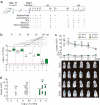Development and multimodal characterization of an elastase-induced emphysema mouse disease model for the COPD frequent bacterial exacerbator phenotype
- PMID: 34252004
- PMCID: PMC8276669
- DOI: 10.1080/21505594.2021.1937883
Development and multimodal characterization of an elastase-induced emphysema mouse disease model for the COPD frequent bacterial exacerbator phenotype
Abstract
Chronic obstructive pulmonary disease (COPD) patients undergo infectious exacerbations whose frequency identifies a clinically meaningful phenotype. Mouse models have been mostly used to separately study both COPD and the infectious processes, but a reliable model of the COPD frequent exacerbator phenotype is still lacking. Accordingly, we first established a model of single bacterial exacerbation by nontypeable Haemophilus influenzae (NTHi) infection on mice with emphysema-like lesions. We characterized this single exacerbation model combining both noninvasive in vivo imaging and ex vivo techniques, obtaining longitudinal information about bacterial load and the extent of the developing lesions and host responses. Bacterial load disappeared 48 hours post-infection (hpi). However, lung recovery, measured using tests of pulmonary function and the disappearance of lung inflammation as revealed by micro-computed X-ray tomography, was delayed until 3 weeks post-infection (wpi). Then, to emulate the frequent exacerbator phenotype, we performed two recurrent episodes of NTHi infection on the emphysematous murine lung. Consistent with the amplified infectious insult, bacterial load reduction was now observed 96 hpi, and lung function recovery and disappearance of lesions on anatomical lung images did not happen until 12 wpi. Finally, as a proof of principle of the use of the model, we showed that azithromycin successfully cleared the recurrent infection, confirming this macrolide utility to ameliorate infectious exacerbation. In conclusion, we present a mouse model of recurrent bacterial infection of the emphysematous lung, aimed to facilitate investigating the COPD frequent exacerbator phenotype by providing complementary, dynamic information of both infectious and inflammatory processes.
Keywords: Lung emphysema; bacterial exacerbation; inflammation; micro-CT; test of pulmonary function.
Figures






Similar articles
-
Experimental pulmonary infection and colonization of Haemophilus influenzae in emphysematous hamsters.Pulm Pharmacol Ther. 2010 Aug;23(4):292-9. doi: 10.1016/j.pupt.2010.02.006. Epub 2010 Mar 6. Pulm Pharmacol Ther. 2010. PMID: 20211751
-
Diminished ICAM-1 expression and impaired pulmonary clearance of nontypeable Haemophilus influenzae in a mouse model of chronic obstructive pulmonary disease/emphysema.Infect Immun. 2008 Nov;76(11):4959-67. doi: 10.1128/IAI.00664-08. Epub 2008 Sep 15. Infect Immun. 2008. PMID: 18794286 Free PMC article.
-
Inflammation and chronic colonization of Haemophilus influenzae in sputum in COPD patients related to the degree of emphysema and bronchiectasis in high-resolution computed tomography.Int J Chron Obstruct Pulmon Dis. 2017 Nov 1;12:3211-3219. doi: 10.2147/COPD.S137578. eCollection 2017. Int J Chron Obstruct Pulmon Dis. 2017. PMID: 29138549 Free PMC article.
-
The Interplay Between Immune Response and Bacterial Infection in COPD: Focus Upon Non-typeable Haemophilus influenzae.Front Immunol. 2018 Nov 5;9:2530. doi: 10.3389/fimmu.2018.02530. eCollection 2018. Front Immunol. 2018. PMID: 30455693 Free PMC article. Review.
-
Understanding nontypeable Haemophilus influenzae and chronic obstructive pulmonary disease.Curr Opin Pulm Med. 2014 Mar;20(2):159-64. doi: 10.1097/MCP.0000000000000023. Curr Opin Pulm Med. 2014. PMID: 24441573 Review.
Cited by
-
Epigenetic control of the ferric uptake regulator (Fur) and fumarate nitrate reductase (FNR) master regulatory proteins contributes to Haemophilus influenzae survival during lung infection.mBio. 2025 Aug 13;16(8):e0135525. doi: 10.1128/mbio.01355-25. Epub 2025 Jul 23. mBio. 2025. PMID: 40698946 Free PMC article.
-
In Vivo Genome-Wide Gene Expression Profiling Reveals That Haemophilus influenzae Purine Synthesis Pathway Benefits Its Infectivity within the Airways.Microbiol Spectr. 2023 Jun 15;11(3):e0082323. doi: 10.1128/spectrum.00823-23. Epub 2023 May 17. Microbiol Spectr. 2023. PMID: 37195232 Free PMC article.
References
-
- Celli BR, Wedzicha JA.. Update on clinical aspects of chronic obstructive pulmonary disease. N Engl J Med. 2019;381(13):1257–1266. Available from: https://www.ncbi.nlm.nih.gov/pubmed/31553837 - PubMed
-
- Wedzicha JA, Seemungal TA. COPD exacerbations: defining their cause and prevention. Lancet. 2007;370(9589):786–796. Available from: https://www.ncbi.nlm.nih.gov/pubmed/17765528 - PMC - PubMed
-
- Hurst JR, Vestbo J, Anzueto A, et al. Susceptibility to exacerbation in chronic obstructive pulmonary disease. N Engl J Med. 2010;363(12):1128–1138. Available from. https://www.ncbi.nlm.nih.gov/pubmed/20843247 - PubMed
-
- Lopez-Campos JL, Miravitlles M, De La Rosa Carrillo D, et al. Current challenges in chronic bronchial infection in patients with chronic obstructive pulmonary disease. J Clin Med. 2020;9(6):1639. Available from: https://www.ncbi.nlm.nih.gov/pubmed/32481769 - PMC - PubMed
Publication types
MeSH terms
Substances
LinkOut - more resources
Full Text Sources
Other Literature Sources
Medical
